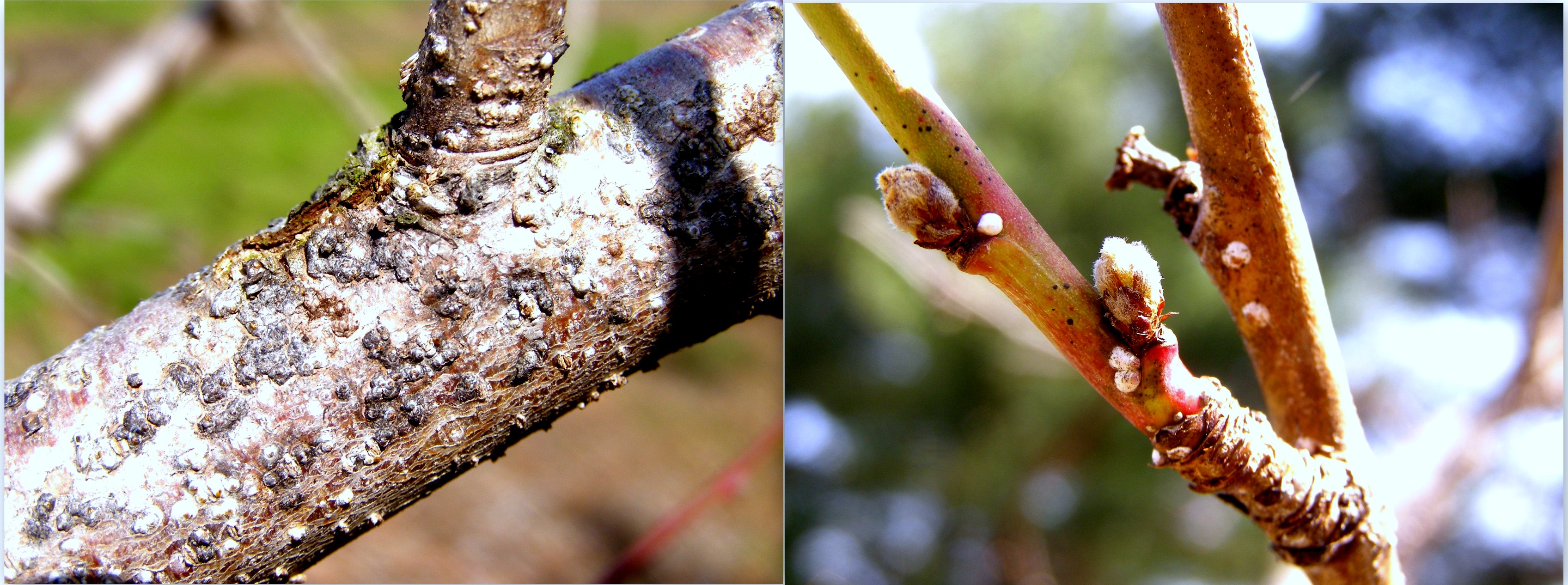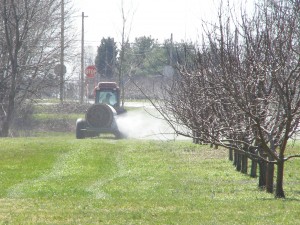- Oil for Pear Psylla and Scale Control
- Scout While Pruning
- Dormant Season Copper Sprays
- Dormant Season Urea Sprays
Oil for Pear Psylla and Scale Control: During the recent warm up pear psylla adults were active, however no egg laying has yet been observed. Growers with pears should be thinking about oil applications to deter egg laying. Oil is used to deter early season egg-laying by pear psylla since adults are repelled by oily surfaces. The objective is to delay egg deposition for as long as possible so that most of the hatch occurs after bloom. We can then target the nymphs during a compressed hatch period. Egg-laying usually commences by early March and gets into full swing by late in the month. So it is good to get the first application of oil on pear trees as soon as the weather permits in March. Oil should not be applied when temperatures are expected to drop below freezing within 48 hours of application. Oil can be safely applied up to the pink stages of peach and apple, and white bud on pear. Delayed dormant applications applied for mite suppression will effectively control scale. Multiple applications are often recommended in apple and may be beneficial where both scale and mites are a concern in peaches. Since conditions are seldom optimal for good coverage in the spring, multiple applications also help to get close to the 100% goal. Where multiple applications are made the rate is generally dropped the closer an application is made to bloom. So a split application in apples for example might consist of a 2% application up to ½” green, and a 1% application up to tight cluster. An application @ ½ % at pink is an option that may provide additional insurance.
One often sees recommendations for mixing OP’s such as Lorsban or Supracide with dormant oil applications to improve scale control. The general consensus seems to be that the addition of these materials is of little benefit. These materials also increase the risk of oil phytoxicity from cold temperatures. These organophosphates also control rosy apple aphid, however in recent years we’ve observed poor control due either to resistance or more likely, poor timing. Combinations of oil with one of the the IGR’s Esteem or Centaur may improve scale control in heavily infested orchards. Esteem applied in the delayed dormant timing will also control rosy apple aphids, and may improve green peach aphid and pear psylla control. Regardless of what’s in the tank, the key to scale control is in good coverage. Take your time and soak the trees especially in blocks known to have scale. See the 2015 New Jersey Commercial Tree Fruit Production Guide for more information.
Oil is also useful to deter early season egg-laying by pear psylla since adults are repelled by oily surfaces. The objective is to delay egg deposition for as long as possible so that most of the hatch occurs after bloom. We can then target the nymphs during a compressed hatch period. Egg-laying usually commences by early March and gets into full swing by late in the month. So it is good to get the first application of oil on pear trees as soon as the weather permits in March. Oil should not be applied when temperatures are expected to drop below freezing within 48 hours of application. If it is too cold For oil applications an alternative is too apply Surround @ 25-50#/acre. Surround also deters egg laying and can be applied regardless of temperature. It has the added benefit that it can be reapplied through the bloom period, by which time early adult activity should be over.

San Jose Scale (Left) and White Peach Scale (Right) on Peach.
Scout While Pruning: Late winter is a good time to scout for infestations of san jose scale and white peach scale. The best time to do this is while pruning since you can give each tree a good look over. By the end of the summer last year we were seeing an increase in the number of orchards infested with white peach scale. These infestations are easy to spot.
Harder to see are san jose scale infestations. (See photo on right) Pruning is also a good time to scout for vole damage.
Dormant season copper Sprays: Coppers are early season fungicides recommended for early season scab control and fire blight suppression in apples and pears. Coppers are also used for peach leaf curl control.
Care must be taken when applying copper to prevent unintended consequences. Copper phytoxicity takes the form of leaf damage on stone fruit and leaf and fruit injury on pome fruit. We recommend post bloom copper applications at very low rates in peach for bacterial spot suppression. But significant phytoxicity can occur from tank mixes, especially when applied after a long period of overcast weather, and/or the spray water ph is less than 6. Therefore it’s recommended to have some ph strips and buffer on hand to test the finished spray mixture and adjust the ph to lessen acidity if necessary. On apples and pears coppers should not be applied much past green tip unless fruit finish is not a concern. Copper ions present after half inch green can cause russett, especially on sensitive varieties. The risk of fruit injury is increased in years with little rainfall between bud break and pink, because more copper will be present when the fruit is fully exposed.
 Dormant season urea sprays: One final March chore is to get a jump on apple scab in orchards that have high inoculum from the previous season. Here orchard sanitation using urea or by shredding leaves is of benefit. Last season’s leaves carry the overwintering inoculum of the fungus. Urea works in two ways to reduce this season’s inoculum: it helps organisms in the groundcover decompose the leaves quickly; it also suppresses the development of spores so that they are not released. Alternatively, chopping the leaf litter with a flail mower will accomplish the same end. This is useful for getting the upper hand on primary scab control and for resistance management. 2013 was the worst scab season we have seen in quite a while. Nearly every orchard we scouted in southern counties had some level of scab infection on the leaves if not the fruit. It is strongly recommended that all growers that had scab last year apply urea if they didn’t already apply it in the fall.
Dormant season urea sprays: One final March chore is to get a jump on apple scab in orchards that have high inoculum from the previous season. Here orchard sanitation using urea or by shredding leaves is of benefit. Last season’s leaves carry the overwintering inoculum of the fungus. Urea works in two ways to reduce this season’s inoculum: it helps organisms in the groundcover decompose the leaves quickly; it also suppresses the development of spores so that they are not released. Alternatively, chopping the leaf litter with a flail mower will accomplish the same end. This is useful for getting the upper hand on primary scab control and for resistance management. 2013 was the worst scab season we have seen in quite a while. Nearly every orchard we scouted in southern counties had some level of scab infection on the leaves if not the fruit. It is strongly recommended that all growers that had scab last year apply urea if they didn’t already apply it in the fall.
Urea is applied at rate of 40# per acre in 100 gallons of water per acre. This can be applied with an airblast sprayer with the nozzles directed at the ground cover. It is best done before bud break but can be applied as late as green tip. Applications made later in the spring should be done with a boom sprayer since urea drifting onto green tissue may make it more susceptible to phytotoxicity from copper or oil sprays.

